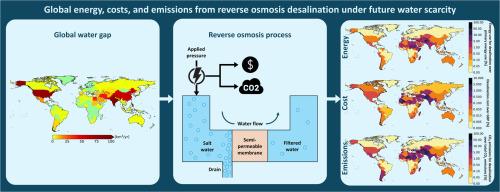在未来缺水的情况下,反渗透海水淡化的全球能源、成本和排放
IF 12.4
1区 环境科学与生态学
Q1 ENGINEERING, ENVIRONMENTAL
引用次数: 0
摘要
海水淡化可以帮助解决水资源短缺问题,但其可持续性受到高能耗和对化石燃料的依赖的限制。通过多模型分析,我们量化了不同气候情景和盐度水平下反渗透海水淡化的能源、成本和排放权衡。在全球变暖3°C的情况下,通过海水淡化解决全球水资源短缺问题每年可能需要高达1,669太瓦时的电力,并导致每年排放10亿吨二氧化碳,占全球能源使用量的1%和排放量的2.5%,成本超过1300亿美元。随着盐度从15至40毫微克/分(典型范围从微咸水到咸水)上升,能源需求增加了74%,强调了盐度在决定海水淡化的经济和环境可行性方面的核心作用。我们发现气候模式的变率往往超过变暖情景之间的差异,这突出了将气候不确定性纳入水资源规划的重要性。就地理分布而言,北非和东非、中东、中亚和南亚的低收入缺水国家面临的挑战最大,因为有限的财政和能源资源阻碍了广泛海水淡化的可行性。如果没有快速的电网脱碳或专用的可再生能源,海水淡化可能会使各国陷入高排放水的未来。确保其长期可持续性将需要低碳能源转型和有针对性的经济支持,特别是对那些最容易受到能源不安全和气候不平等影响的国家。本文章由计算机程序翻译,如有差异,请以英文原文为准。

Global energy, costs, and emissions from reverse osmosis desalination under future water scarcity
Desalination can help address water scarcity, but its sustainability is limited by high energy use and dependence on fossil fuels. Using a multi-model analysis, we quantify the energy, cost, and emissions trade-offs of reverse osmosis desalination under various climate scenarios and salinity levels. Under 3°C of warming, addressing global water scarcity through desalination could require up to 1,669 TWh of electricity per year and result in annual emissions of 1 billion tons of CO₂ – accounting for ∼1% of global energy use and 2.5% of emissions – with costs exceeding $130 billion. As salinity rises from 15 to 40 ppt – the typical range from brackish to saline water – energy demand increases by 74%, underscoring the central role of salinity in determining desalination's economic and environmental viability. We find that climate model variability often outweighs differences between warming scenarios, highlighting the importance of incorporating climate uncertainty into water resources planning. In terms of geographical distribution, low-income, water-stressed countries in North and East Africa, the Middle East, Central Asia, and South Asia face the greatest challenges, as limited financial and energy resources hinder the viability of widespread desalination. Without rapid grid decarbonization or dedicated renewable energy, desalination risks locking countries into a high-emissions water future. Ensuring its long-term sustainability will require low-carbon energy transitions and targeted economic support, especially for nations most vulnerable to energy insecurity and climate inequality.
求助全文
通过发布文献求助,成功后即可免费获取论文全文。
去求助
来源期刊

Water Research
环境科学-工程:环境
CiteScore
20.80
自引率
9.40%
发文量
1307
审稿时长
38 days
期刊介绍:
Water Research, along with its open access companion journal Water Research X, serves as a platform for publishing original research papers covering various aspects of the science and technology related to the anthropogenic water cycle, water quality, and its management worldwide. The audience targeted by the journal comprises biologists, chemical engineers, chemists, civil engineers, environmental engineers, limnologists, and microbiologists. The scope of the journal include:
•Treatment processes for water and wastewaters (municipal, agricultural, industrial, and on-site treatment), including resource recovery and residuals management;
•Urban hydrology including sewer systems, stormwater management, and green infrastructure;
•Drinking water treatment and distribution;
•Potable and non-potable water reuse;
•Sanitation, public health, and risk assessment;
•Anaerobic digestion, solid and hazardous waste management, including source characterization and the effects and control of leachates and gaseous emissions;
•Contaminants (chemical, microbial, anthropogenic particles such as nanoparticles or microplastics) and related water quality sensing, monitoring, fate, and assessment;
•Anthropogenic impacts on inland, tidal, coastal and urban waters, focusing on surface and ground waters, and point and non-point sources of pollution;
•Environmental restoration, linked to surface water, groundwater and groundwater remediation;
•Analysis of the interfaces between sediments and water, and between water and atmosphere, focusing specifically on anthropogenic impacts;
•Mathematical modelling, systems analysis, machine learning, and beneficial use of big data related to the anthropogenic water cycle;
•Socio-economic, policy, and regulations studies.
 求助内容:
求助内容: 应助结果提醒方式:
应助结果提醒方式:


